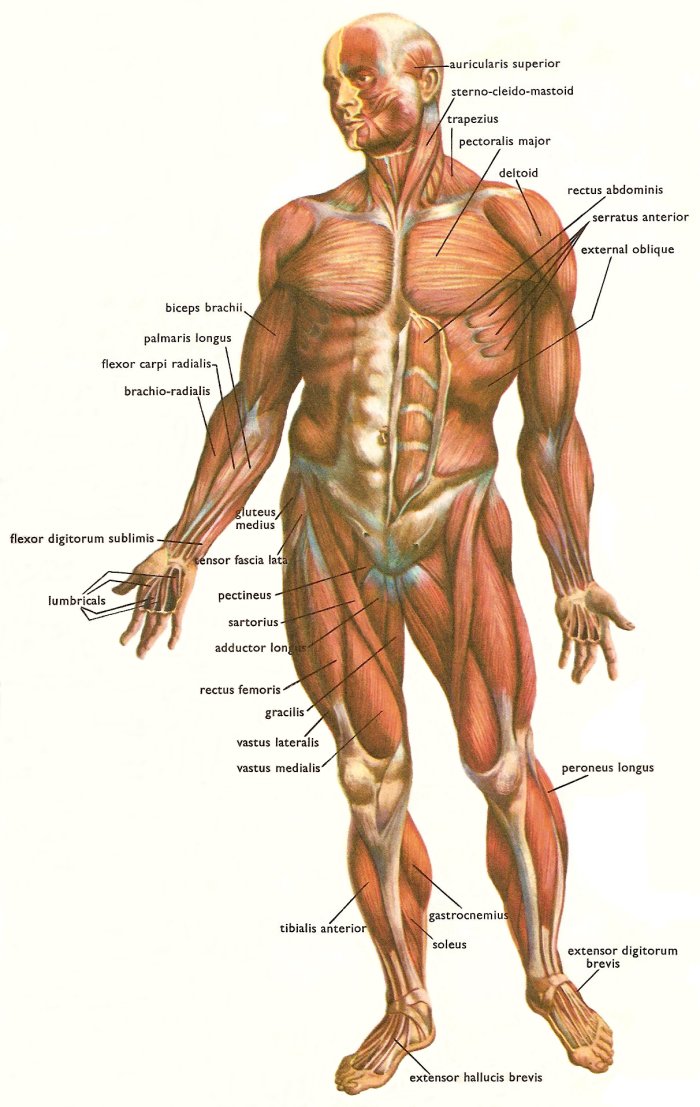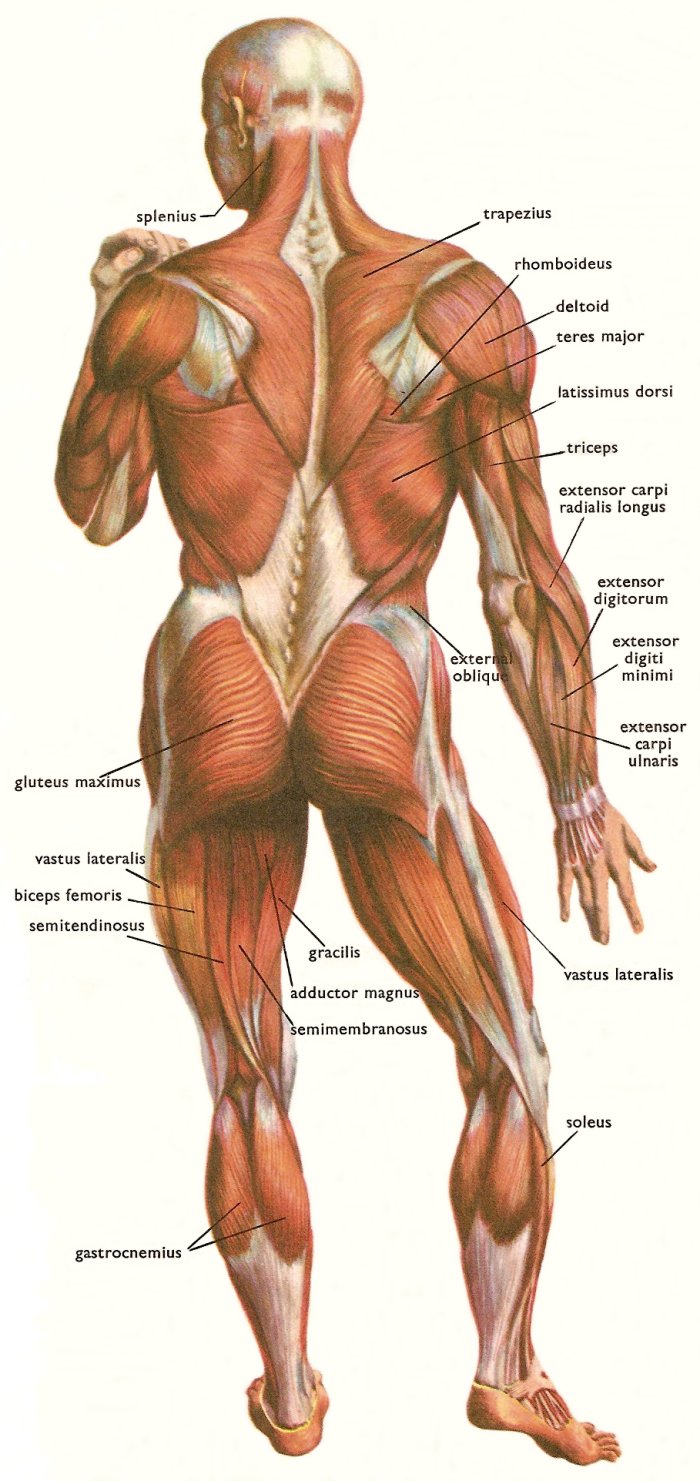
Facts About Massage and the Human Body
Spinal cord:
- 1. How many pairs of cervical nerves are there?
8
- 2. How many total spinal nerves are there?
62
- 3.Wich of the following structures is known as the “horse’s tail”?
Cauda equina
- 4. The length of the average adult spinal cord is:
16 – 18 inches
- 5. The largest nerve in the body is:
Sciatic
- 6. Carpal tunnel syndrome results from damage to what nerve?
Median nerve
- 7. The two divisions of the sciatic nerve are:
Tibial and common Peroneal nerve
- 8. What nerve innervates the diaphragm? From which plexus does it arise?
Phrenic nerve; cervical plexus
- 9. Damage to the cervical plexus may cause:
Respiratory arrest
- 10. Which plexus supplies the buttock muscles?
Sacral plexes
Muscles:
- What muscles make up the quadriceps femoris?
Vastus medialis, vastus intermedius, vastus lateralis, and rectus femoris
- How many intermediate (midpalmar) intrinsic muscles of the hand, which act on all the digits except for the thumb, are there?
11
- Which of the following muscles has an action of flexing and rotating the neck and assists in inspiration?
Anterior scalene
Posterior scalene
Middle scalene
- Runner’s knee” is more technically know as:
Patellofemoral stress syndrome
- The muscle whose action makes you smile is:
Zygomaticus major
- The erector spinae is composed of which muscle groups?
Longissmus, iliocostalis, and spinalis
- Which of the following muscles aids in inspiration?
External intercostal
8. Which muscle is considered to be the “chewing” muscle?
Masseter
- . The calcaneal tendon is able to withstand a 1000 pound force without tearing
- Which of the following muscles directly connects the trunk to the upper extremity?
Pectoralis major and latissimus dorsi
11. What is the stronges single muscle in the body?
Gluteus maximus
12. The muscles making up the hamstrings are:
Semimembranosus, semitendinosus, and biceps femoris
- 13. The strongest tendon in the body is the:
The Achilles tendon
- 14. As a general rule, the attachment of a muscle tendon to a stationary bone is called the:
Origin
- 15. If someone loses the ability to point with his index finger, you would suspect a problem with:
Extensor Indicis
- 16. What is the longest muscle in the body?
Sartorius
- 17. The muscles that make up the rotator cuff are:
Supraspinatus, infraspinatus, teres minor, and subscapularis
18. There are actually three types of muscle in the human body, which are skeletal, cardiac, and smooth. The skeletal muscles are, as you would have guessed, are attached to the bones by tendons. The role of these guys is to move the skeleton (i.e. walking, swinging your arms, or turning your head), to help us maintain posture while sitting or standing, and in a general sense, to create force through movement. These muscles can be controlled both consciously and unconsciously, and make up about 42% of the average man's body mass and 36% of the average woman's.
19. The cardiac muscles are found only in the heart (hence the name). Although these muscles resemble skeletal muscles in structure, they operate on a completely involuntary basis, which is why we don't have to command the heart to beat--it just does! And last, but not least, we have the smooth muscles, which are contained mostly in the walls of organs. This type of muscle also moves on an involuntary basis. For instance, when food is pushed along through the intestines, these muscles are working within the intestines and without our conscious effort.
20. Although most of us have heard that the tongue is the strongest muscle in the human body, this is simply not true. 1) Because the human tongue consists of sixteen different muscles, not just one, and 2) because there are simply too many different ways to determine "strength". If we were to try to determine the strongest muscle based off of the amount of work that the muscle does over its lifetime, the heart would take first place. However, if we were to say that strength should be measure on a "pound for pound" scale, the uterus would likely take the gold. But, if we want to determine the strongest muscle in terms of how much raw force it can exert, it would be the jaw muscle.
21. The biggest muscle is the GLUTEUS MAXIMUS in the buttock:
22. The smallest the STAPEDIUS deep in the ear. It is thinner than cotton thread.
23. The face contains more than 50 muscles, which gives us our huge range of facial
expressions
- 24. About one person in 20 has two extra ribs, making 13 pairs instead of 12.
- 25. Bone is one of the strongest known materials for it’s weight.
- 26. Each of our bones contain about 1/5 WATER, which means the whole skeleton of an adult contains more than 2 Liters of WATER.
- 27. 5 more facts about muscles
They are made of muscle cells called myofibers. Each myofiber is covered in fascia.
Muscles use calcium to trigger contractions. They use ATP for energy. They have
contractile units called sarcomeres.
Some other random science facts about our body
1. Healthy nails grow about 2 cm each year. Fingernails grow four times as fast as toenails.
2. 20/20 vision means the eye can see normally at 20 feet. 20/15 is better; the eye can see at
20 feet what another eye sees at 15 feet.
3. The average person has 100,000 hairs on his/her head. Each hair grows about 5 inches (12.7 cm) every year.
4. There are 60,000 miles (97,000 km) in blood vessels in every human.
5. The average human produces a quart of saliva a day -- about 10,000 gallons in a lifetime
6. 70% seventy percent of the dust in your home consists of shed human skin
7. Oxygen, carbon, hydrogen and nitrogen make up 90% of the human body.
8. Most people blink about 17,000 times a day.
9. The human head is a quarter of our total length at birth, but only an eighth of our total length by the time we reach adulthood.
10. The human body has enough fat to produce 7 bars of soap.
11. Muscles in the human body (640 in total) make up about half of the body weight.
12. Muscles are made up of bundles from about 5 in the eyelid to about 200 in the buttock muscle.
13. There are more living organisms on the skin of a single human being than there are human beings on the surface of the earth.
14. If your mouth was completely dry, you would not be able to distinguish the taste of anything.
15. The brain uses more than 25% of the oxygen used by the human body.
16. Every minute, 30-40,000 dead skin cells fall from your body.
17. 15 million blood cells are produced and destroyed in the human body every second.
18. In your lifetime, you'll shed over 40 pounds of skin.
19. As an adult, you have more than 20 square feet of skin on your body--about the same square footage as a blanket for a queen-sized bed.
20. Everyone's tongue print is different.
21. The human brain is 80% water.
22. Only humans sleep on their backs.
23. Our eyes are always the same size from birth, but our nose and ears never stop growing.
24. It's impossible to sneeze with your eyes open.
25. The heaviest human brain ever recorded weighed 5 lb. 1.1 oz. (2.3 kg.).
26. The longest living cells in the body are brain cells which can live an entire lifetime.
27. 40 to 50 percent of body heat can be lost through the head (no hat) as a result of its extensive circulatory network.
28. Human jaw muscles can generate a force of 200 pounds (90.8 kilograms) on the molars.
29. It takes approximately 12 hours for food to entirely digest.
30. Did you know that there are 206 bones in the adult human body and there are 300 in children (as they grow some of the bones fuse together).


